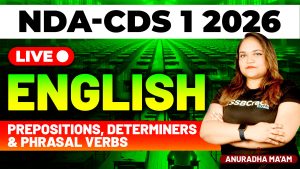Geometry is one of the fundamental topics in the CDS Maths syllabus, challenging candidates to apply spatial reasoning and knowledge of geometric principles. In a recent class, students focused on tackling MCQs from previous CDS exams and expected questions based on essential geometry topics. This class gave students an opportunity to solidify their understanding through practice, recognize common question patterns, and develop effective strategies to approach geometry problems confidently and efficiently. Here, we’ll cover the insights shared in the class and strategies for a successful preparation approach for geometry in the CDS exam.
Topics Covered and Key Focus Areas
The MCQs practiced in the class spanned the core concepts in geometry, with an emphasis on their application in typical CDS exam scenarios. Topics covered included:
- Lines, Angles, and Transversals
Questions in this area focused on understanding how lines interact, including intersecting and parallel lines, as well as the angles formed by a transversal crossing these lines. Important angle properties, such as alternate, corresponding, and interior angles, are often tested in straightforward and combined question forms. Students practiced identifying angle relationships and using them to find missing angles efficiently. - Triangles and Triangle Properties
Triangles are a central topic, so candidates reviewed the properties of various types of triangles and the relationships between their sides and angles. MCQs involved applications of the basic proportionality theorem, median and centroid properties, and concepts related to the incenter, circumcenter, and orthocenter. Students practiced solving for unknowns in triangles and used triangle similarity and congruence principles, which are frequently tested in the CDS exam. - Quadrilaterals and Polygons
The class also delved into quadrilaterals, especially parallelograms, rectangles, squares, and rhombuses. These shapes come with unique properties, such as the relationships between opposite sides, diagonals, and angles, making them a common focus in the CDS geometry section. Regular polygons and their angle properties were also reviewed, emphasizing questions on both internal and external angles. - Circles and Tangent Properties
Circles, with their many related theorems, are a crucial part of geometry. The class tackled MCQs involving properties of chords, tangents, secants, and angles subtended by arcs. Key concepts included understanding the angle subtended by a diameter, properties of tangents from an external point, and the relationships between intersecting chords. These concepts are important since questions on circles often appear in both basic and advanced formats on the CDS exam. - Geometric Theorems
Students also practiced MCQs that required applying the Pythagorean theorem, angle bisector theorem, and properties related to congruence and similarity. These theorems are foundational in solving both direct and complex geometry questions. By repeatedly applying these theorems across a variety of questions, students learned to identify which theorems are relevant to each problem type.
Strategies for Preparing Geometry for the CDS Exam
- Understand Core Theorems and Properties
Geometry relies heavily on the application of fundamental theorems and properties. Instead of simply memorizing these rules, focus on understanding the reasoning behind them. This comprehension will allow you to adapt to different types of questions, even those that combine multiple concepts in new ways. For example, understanding why the angle sum of a triangle is constant can help solve problems involving polygons with more sides. - Practice Previous Years’ Questions
Practicing past exam questions gives insight into the pattern, type, and difficulty level of the questions you might encounter. Start with questions on basic concepts and gradually move to questions involving multiple steps and advanced applications. As observed in the class, CDS geometry questions often follow patterns, so recognizing these can be a big advantage. - Use Visuals and Diagrams Effectively
Geometry is highly visual, and drawing accurate diagrams can clarify relationships within a problem. Take time to draw diagrams and label known elements, especially in questions involving multiple figures or angles. Diagrams help identify solutions and are essential when dealing with questions on tangents, chords, or polygons. - Time Management
Since geometry questions can vary in difficulty, manage your time efficiently by categorizing questions into direct and complex types. Tackle simpler questions first to secure easy marks, and then allocate time to work through more involved problems. Practicing under timed conditions, as in mock tests, can greatly improve speed and efficiency. - Master Key Properties of Circles and Triangles
Many CDS geometry questions focus on properties of circles and triangles, so mastering these areas is essential. Review circle theorems such as those involving tangents, chords, and arc angles. In triangles, familiarize yourself with concepts like similar triangles, angle bisectors, and centers (incenter, circumcenter, etc.). Practice questions that require combining multiple properties, as these are common on the exam. - Analyze Mistakes and Learn from Them
During practice, keep track of mistakes and revisit the concepts or steps that led to incorrect answers. Reviewing mistakes allows you to recognize patterns in your errors, like misinterpreting diagrams or forgetting to apply a theorem. As seen in the recent class, analyzing past mistakes provides valuable insights and reduces the chances of similar errors in the future. - Mock Tests and Revision
Regularly taking mock tests will expose you to a variety of question types and difficulty levels. After completing a test, review each question and ensure you understand the reasoning behind each answer. Periodic revision of core topics, especially previously challenging ones, solidifies your understanding and ensures you retain knowledge over time.
Conclusion
Geometry for the CDS exam can be both challenging and rewarding. The recent class emphasized the importance of thorough practice, focusing on both foundational principles and advanced applications. By reviewing MCQs from previous years, students gained confidence and developed familiarity with common question types, a vital skill for exam day.
To excel in CDS geometry, focus on understanding rather than rote learning, utilize diagrams effectively, and practice extensively under timed conditions. With consistent effort and a clear problem-solving strategy, you can master geometry and secure essential marks in the CDS Maths exam. Remember, each question is an opportunity to apply your knowledge and problem-solving skills, and every bit of practice brings you closer to achieving your exam goals.



















